ARTICLES: All About Opal Gemstone and Opal Astrology
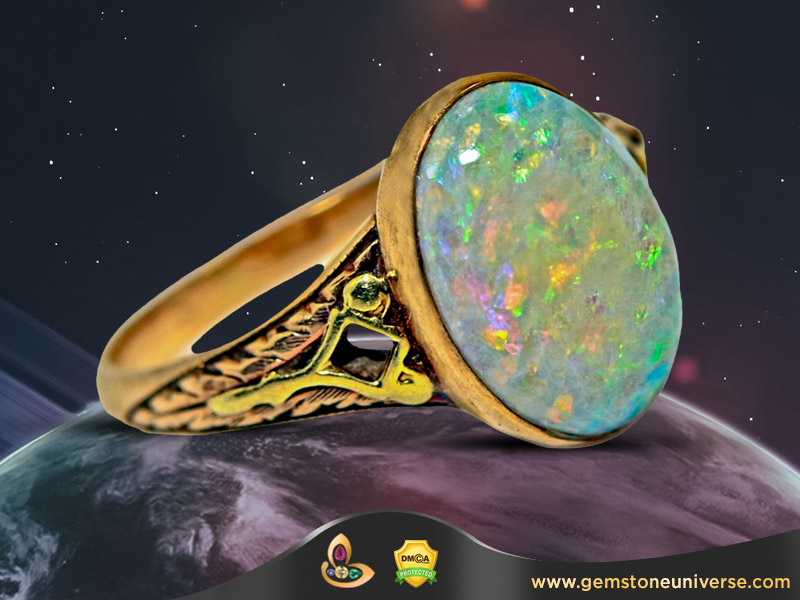
Clicking on Underlined Links will give more information about a topic. You can always come back to this page
What Problems Can Astrology & Jyotish Gemstones Solve? Can they solve My Unique problems
Which is the Best Gemstone Choosing Method | Which Gemstone Should I wear
Do Gems Work- No They Don’t for 90% of the People-Why?.
What results Can I expect from Jyotish Gemstones?
In Quest of India’s Best Gemstone Astrologer.
Tell me My Best Life Changing Gemstone
The Opulence of Opal -The Mystique and Beauty of Nature
All About Opal Gemstone and Opal Astrology
Gemstoneuniverse-The Gold Standard in Planetary Gemology
Opal & Play of color! Ethiopian Soil Enters Gemstoneuniverse in form of Opals!
The Opal is a fine example of showcasing nature’s infinite capacity to generate the WOW factor. The Opal stone is an amazing visual treat with brilliant colours in all hues visible in the single stone. In fact is the only gem in which all the visible colours of the spectrum can be seen . The Opal is mainly composed of Silica with about 3-10 per cent of water content. Opals formed millions of years ago when silica gel trapped between layers of host rock got hardened.
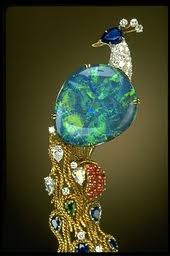
Ornate Jewelry Masterpiece with the Opal as the Center Gem
A beautiful piece of jewellery fashioned with opal as a centrepiece
( Image Courtesy : www.jewelinfo4u.com )
The name opal is a derivative of the Greek work Opalus, which is further thought to owe its origins to the Sanskrit word Upala and Upalamani is how the Opal have been known in the ancient Indian texts.
Bhuswabhavavriddhi ratnani jatani vividhani tu I
Upala ratnaroopatvam praptaah kalantaren va II
- Ratnapariksha
The Opal was valued highly by the ancients until towards the middle of 19 th century. From the writings of Pliny the Elder, the famed Roman author, one gets to know of a particularly beautiful Opal set in a ring possessed by a Roman senator called Nonius (hence known as the Opal of Nonius ), which was at that time valued at 2,000,000 sesterces.
Mark Antony’s desire to have it was met with a refusal from Nonius, who fled leaving everything behind but the Opal. George F. Kunz mention’s in his seminal book, The Curious Lore of Precious Gemstones , a splendid opal by the name of Orphanus that was set in the imperial crown of the Holy Roman Empire. They say that a stone like it was never seen before and that possibly led to its gaining the name orphanus!
The Opal comes in many varieties and is chiefly sourced in Australia. However, it is also found in Brazil, Honduras, Ethiopia, Japan and the US. Fire Opal is found in Mexico only.
The stone is relatively soft and brittle and needs extra care in handling and a protective covering when setting it as jewellery. Since the Opal has a large amount of water, exposure to heat can result in loss of water and hence cracking of the stone or developing fracture like lines. This phenomenon is known as crazing . Opal is stored in water for the same reason. People who save it in vaults often keep it with a piece if moist cloth. The exposure of Opals to ultrasonics, steamers, heat and chemicals should be avoided.
The only Opal hard enough to withstand faceting are some fire opals. Opals are usually fashioned as flat pieces or domed cabochons. Since the mineral matter is so fragile here Opal is often fashioned as doublets or triplets. This however makes a dent on its value but ensures that the Opal is safeguarded against damage to a large extent.
A doublet opal is not a solid opal but is a thin slice of real opal which has ironstone/ black potch/ obsidian /basalt /glass glued to its back to give it more strength. Also a darker helps emphasize the play of color helping the stone fetch more value.
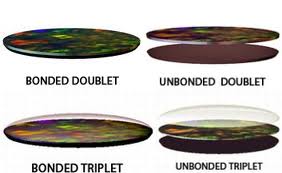
Doublets and Triplets in Opals
(Image courtesy: netstore.net.au)
The triplet Opal is a doublet opal whose upper surface has further a transparent clear glass or quartz domed cap attached. While the base helps bring out play of color, the domed cap magnifies the opal and protects it as well. The doublet and triplet opals are good for jewellery making only and have no value in planetary gem therapy.
The Opal displays two characteristic optical phenomenon -
Play of Color : It is the display of shifting spectral colors and is caused due to its internal structure where silica spheroids are arranged in a periodic patterned fashion.
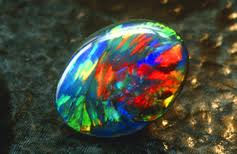
A fine Opal Specimen exhibiting the play of color
(Image courtesy: thecoutureshow.com)
Opalescence : It is a phenomenon displayed by the milky white and blue opal. It is NOT the play of color and Play of color is NOT Opalescence!
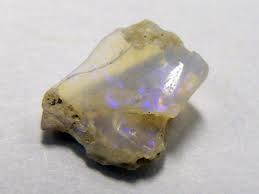
Opalescence exhibited in Opal Raw
(Image courtesy: uk.ask.com)
Varieties of Opal:
Potch : Very common. Translucent opal with hardly any play of color. Occurs in many body colours.
Black Opal : It is one of the most valuable types of opal. Any Opal that displays good play of color against a dark background is known as a black opal. The entire range of colours can be seen against the dark background. The ones that have a red or orange play of colour are highly valued. The opals with a greyish background color are called semi-black opals .
Light Opal : Opals with a white, milky white or translucent background are called light opals. Those with low transparency and less play of color beget a lower value. On the contrary, an opal with high transparency and lots of play of color can fetch a very handsome price. These are also known as crystal opals .
Boulder opal : in this case the opal comes naturally attached to the host rock where it was formed. It is usually cut in irregular shapes.
Matrix Opal : In this variety, the silica gel formed opal by streaking across the host rock rather than forming a uniform layer. Yowah opal of Australia is an example.
Fire Opal : ranging from reds, yellows and browns, it is a transparent or translucent stone with no or some play of colour. The only known source is Mexico.
Opal in Planetary gem therapy is a gem for Venus, but it is prescribed in certain conditions, especially is the Venus is favourable for the individual but not placed well in the horoscope. Its planetary power is immense – the gem is capable of bestowing all material pleasures, adding charisma and improving interpersonal relationships. Young individuals are generally advised against wearing it despite benefits gained through this gem. Strange as it may sound, opal gives the wearer a taste of all luxuries and then makes the individual disinterested in it all! The mind instead gets more tuned to spirituality and god.
Splendid Specimens of Opal:
Feast your eyes on some of the famous opals that the world has known :
The Andamooka Opal :
It was presented to Queen Elizabeth II on her first visit to Australia in 1950. Weight of the opal is 203 carats.
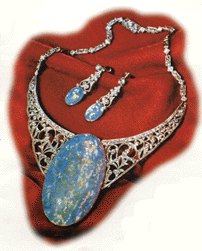
Andamooka Opal Presented to Queen Elizabeth
( Image Courtesy : www.altmanncherny.com.au )
The Flame Queen :
It is a massive and spectacular gem at 263.18 carats! The best visual example of eye of opal, a stone that gets created when mineral gel fills a cavity to form a precious stone. No wonder that the Opal was referred to as Opthalmius, by the early writers.
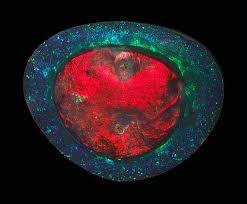
Flame Queen Opal
( Image Courtesy : www.curatedobject.us )
The Galaxy Opal:
It is the largest polished opal at 3,749 carats. Found in Brazil, now it is a part of private collection.
\
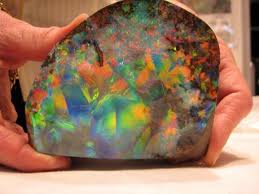
Galaxy Opal
( Image Courtesy : www. opal-network.com)
The Halley’s Comet Opal:
It is the largest uncut Black opal in the world, weighing 1,982.5 carats.
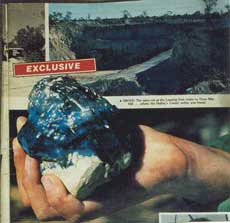
The Halley’s Comet Opal
( Image courtesy : www.grahamblackopal.com )
The Roebling Opal:
The stunner at 2565 carats rests with the Smithsonian National Museum of Natural History.
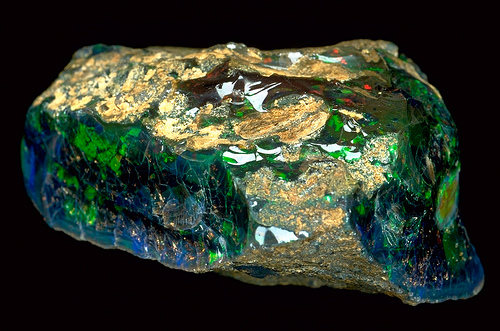
Roebling Opal
( Image courtesy : www.mnh.si.edu)
| Refractive Index | 1.44 – 1.47 |
| Specific Gravity | 1.98 – 2.20 |
| Hardness on Moh’s Scale | 5.5 – 6.5 |
| Crystal structure | Amorphous |
| Cleavage | None |
Ethiopian Soil entered Gemstoneuniverse in form of 12 Kg’s of Opals. We feel blessed. Here are the videos. Some of our team members felt that the video should be without any defining captions and that Gem lovers should not be distracted from the beautiful experience when viewing the video and some felt that Caption adds value and greater insight. So what we do, we do both versions!. Here are two videos of this treasure bestowed by mother earth. One with Captions and one without the Captions:
Opal/ Opals Play of color and falling in Love one more time (Opal Video without Captions)
Opal & Play of color-Ethiopian Soil Enters Gemstoneuniverse in form of Lovely Opals!( Video with Captions)

Abhijita Kulshrestha Senior consultant and PGA- Gemstoneuniverse
Abhijita Kulshrestha is a communications professional and held the position of Research Associate at MICA- Mudra Institute of Communications Ahmedabad before becoming certified Planetary Gem Advisor from PGA Thailand. At present she is a senior consultant at Gemstoneuniverse.com
<p >©1999-2011, Gemstoneuniverse.com, All rights reserved.
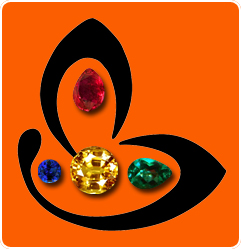
http://www.gemstoneuniverse.com
Gemstoneuniverse-The Gold Standard in Planetary Gemology
Clicking on Underlined Links will give more information about a topic. You can always come back to this page
What Problems Can Astrology & Jyotish Gemstones Solve? Can they solve My Unique problems
Which is the Best Gemstone Choosing Method | Which Gemstone Should I wear
Do Gems Work- No They Don’t for 90% of the People-Why?.
What results Can I expect from Jyotish Gemstones?


